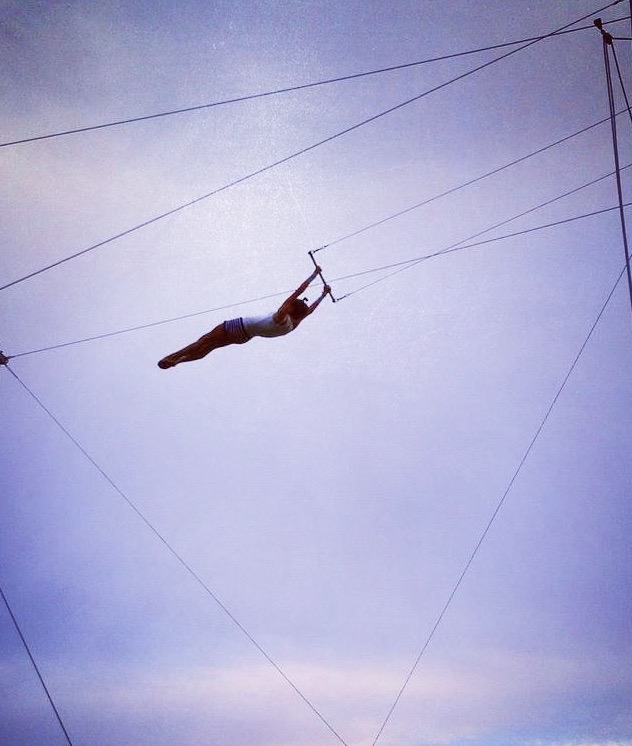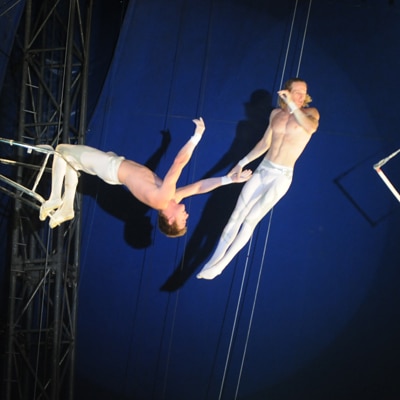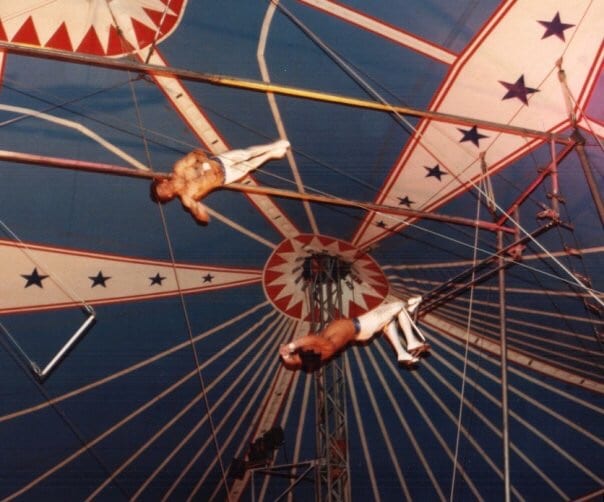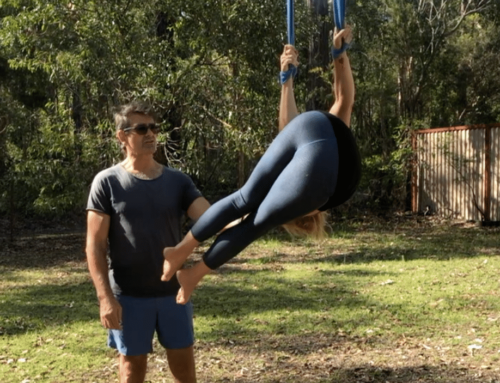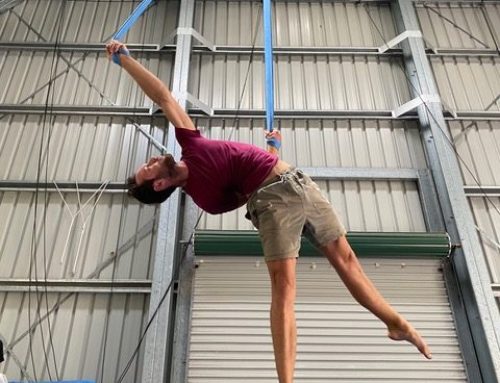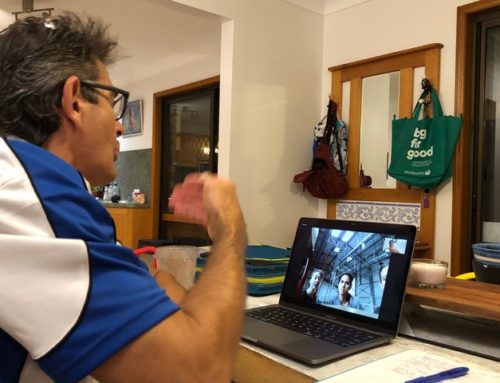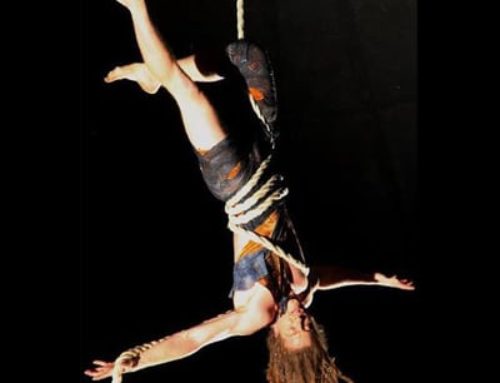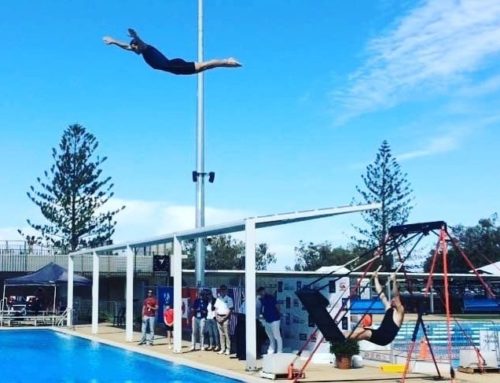Pendulum (from the Latin word “pendulus” which means “hanging”)
Flying trapeze
This is the first part of a 4-part series of blogs focussing on the acts using swinging (pendulums) in the circus industry, and in my opinion, no circus show seems complete without a swinging act. Movies have been made about the daring and dangers of swinging acts because audiences love to see swinging acts, either despite the intrinsic danger, or because of it. Amazing feats of daring, strength and acrobatic virtuosity continue to evolve, and maintain the entertainment value of this extremely difficult discipline.
The swing of the flying trapeze kidnapped me into circus. I was a 10-year-old kid when I had my first swing on a flying trapeze. To be honest, it was terrifying, but when I dropped into the safety net, I was confusingly surprised at what an amazing feeling I had experienced. I immediately went up for a second swing, despite my fear. I can’t remember making a conscious decision at that time, but it’s almost like I knew from then, that one day, I would be a flying trapeze performer. I was fortunate enough to be able to make that dream come true, but I had a few important lessons to learn along the way. I hope that my experiences can help someone else to achieve their own dreams of becoming a flying trapeze performer.
My earlier teachers of the art of flying trapeze were the stars of the many flying trapeze acts that I spent hours watching on videos. I noticed that the flyers who could swing the highest, were able to do the best tricks to the catcher. They made their swings look so easy without putting in very much obvious effort, and they would constantly get their body above the crane bars, which was my goal. When I was able to train flying trapeze more consistently, I would try to copy them, but not always with the success that I expected. I did not understand why some things I tried helped me gain height while other things were just a waste of energy. When I made a comparison between flyers who gained height easily with those who did not, I started to see some common mistakes, and had to concentrate to avoid making those same mistakes. My favourite treat at the end of a training session was to drop into the safety net from the highest point that I could build my swing to. This is what gave me the real feeling of flight, and was a great incentive to be able to build a high swing, while turning me into an adrenaline junkie!
Once, when I asked one of the more experienced flyers that I knew, how I could gain more swing height, he did a demonstration using a string with a weight tied to the end of it. While holding the free end of the string, he would swing the weight from side to side until it made a 180-degree angle at its highest points. Then he held his hand still, and the weight immediately started to lose height. He swung the weight again to full height, and this time he used his free hand to push the weight down from the highest point of its arc, and explained that the speed of his push helped the swing maintain its height. Finally, he swung the weight all the way around his finger in a full circle so that the string started to wind up around his finger. I noticed that he hardly needed to move his hand and the weight continued to whizz around faster and faster as the piece of string became shorter. His explanation following that demonstration was that the shorter we make the length of the pendulum, the easier it is to gain height. I have since learned that there are other factors that influence the height of a pendulum, gravitational pull (momentum), amount of weight at the end of the pendulum, tension in the cables/ropes/pipes and air friction, which seems negligible, but try swinging outside when its windy, and you will understand how this applies.
The only two ways that we can increase the amplitude of a swing (without any mechanical assistance) is through shortening the radius of the pendulum, by moving your body weight closer or further away from the point of attachment. The other is speed, which is achieved each time the pendulum starts to drop back down (gravitational pull) after reaching its maximum height. In order to increase the speed of a swinging trapeze, (whether you are standing on top of the trapeze bar or hanging underneath it), you have to make your movements faster than the existing speed of the swing. The only way that this can be achieved is when human strength and energy (which is potential energy), increases momentum (which is kinetic energy.) Using physical strength during the movements of the swing, when applied at the correct time, adds to the momentum that the gravitational pull has on your body weight. Speed creates height, and if your movements on the trapeze can be energetic enough to add momentum to the speed of the gravitational pull, you will gain height.
What about flying trapeze where the student is limited to mostly hanging by their hands under the trapeze bar? The help that the flyers get from standing on a platform is taken for granted because not many students have the strength or endurance to build up a swing from a still-hanging position at suspension point. The angle of the cables of the trapeze bar is about 60 degrees, while the flyer is standing on the lowest part of the platform. The objective is to build the swing height up to 180-degrees. The only way to shorten the distance between the flyer’s body and the bearing point is by pulling up and tucking your body to decrease the overall length of the pendulum (cables plus length of the body of the flyer). If any of you have tried doing a pull-up on a swinging trapeze, you will know how much strength this requires! It makes more sense to add speed to the pendulum because that requires less strength. This is achieved by the flyer creating a pendulum under the trapeze bar, and these need to be timed in such a way that the flyer does not collide with the immovable platform at the back of their swings. As much as a platform helps at the start of the flyer’s swing, it hinders the efficiency of gaining height at the back of the swing.
The only way that flyers can increase the speed of the flying trapeze swing is by adding effort to their “beats” (or “tempos” or “sweeps”.) If your beat is as fast as the speed of the swing, you will not gain height, but you might at least maintain height. The first beat should take place as soon as the flyer leaves the platform, adding to the gravitational pull before the suspension point of the swing. For backwards rotating skills, the “beat” is also the last thing that a flyer does before releasing the trapeze bar and “throwing” the trick. It is partly the trapeze bar that “throws” the flyer into the air, and the height that the flyer is “thrown” is in direct proportion to the effort what they put into their beat. When I asked my friend Miguel Vasquez (first flyer to catch the incredible quadruple somersault) how he achieved so much height after he released the trapeze bar, he told me that in order to beat hard enough, he would think of trying to pull the crane bar down on you.) The effort that is applied to the swing to make the beat “hard” essentially also makes the beat “fast”. No wonder most accomplished flying trapeze performers end up needing shoulder surgery eventually!
Getting back to the science, the only places to “shorten” the overall length of the pendulum is at the top of the swing in both the front and the back of the swing. The “force out” is the term given to the actions at the front of the swing. Essentially, the flyer wants to shorten the pendulum by pulling the trapeze bar to their chest and tuck their legs as close to the bar as possible. This all happens just before the peak of their swing when the pendulum reaches its slowest speed. This gives the flyer time to force their legs upwards and out to achieve a straight body position from the tucked position, and at the same time, pushing the bar from your chest upwards will now add height to the pendulum. This takes a large amount of effort and is one of the hardest movements to master on the flying trapeze swing. Check out the size of the abs, biceps and lats on the best flyers as proof of this!
The backwards swing on the flying trapeze starts when gravity pulls the flyer down and it’s time to prepare for the beat to speed up the swing again. The flyer should fold into a pike position so that they have a good range of movement to beat back with speed and this should start before the suspension point of the swing. In order to shorten the pendulum, the flyer needs to kick their legs under the trapeze so that their knees go towards their hands and this keeps their centre of mass (hips) as close to the pendulum bearings. If the flyers are strong enough, they can try pulling on their arms to shorten this distance even more. Just before the pendulum reaches its maximum height, stretch your hips as far behind you as possible to add length to the pendulum before gravity starts pulling you back down into your next forward swing. It will be hard to keep your legs from falling down on top of the platform, so it is necessary to do a big pike to avoid hitting the platform. This will, in turn, assist the next beat to be as fast as possible. Have you ever wondered why flying trapeze coaches shout loudly when they want you to beat? No, it’s not because the wind is blowing around your ears, it’s because they are trying to help you add power to your beat. It just would not be the same if they did not emphasize it so loudly. Next lesson, thank them for trying to help you swing higher!
The catcher is a good example of using only speed to gain height. In the classical “wrap around” style catch bar, the catcher can only gain height while in a sitting position, and only goes upside down to catch the flyers. The catcher builds up their swing by leaning forwards and backwards to start a small swinging action. This action encourages gravity to create some momentum, which contributes to building height. The following movements of the catcher is to lean back while holding the cables which will bend them and effectively shorten the length of the pendulum, even by just a little, helping them gain more height. The catcher’s swing loses height when they hang upside down since they increase the length of the pendulum. This needs to be taken into account, and their height confirmed before they get into the catcher’s lock position to face the flyer. To a small extent, the catcher can gain some height while hanging upside down by their knees by employing an inverted “beat” under the catch bar with their upper body. Since they usually only have one or two swings in order to do this before making a catch, only minor timing errors can be corrected by the catcher.
After making a catch, the sudden added length of the flyer’s extended body to that of the catcher and the cables of the catch bar, should encourage them to lose height, but the momentum added by the gravitational pull on the additional weight of the flyer to the catcher, cancels out the height loss. Generally, the original height of the catcher at catch point could be maintained throughout the swing with the flyer. The flyer’s swing with a catcher can be difficult, since there are two different small pendulums influencing the now extended pendulum length of the catch bar. It is usually the case that the catcher remains still and tight, so as to become an extension of the cables of the catch bar. The flyer should use the same beating techniques while hanging under the catcher as they would normally use on the trapeze bar. At the point of the “return”, both flyer and catcher will push away from each other with straight arms so that the flyer can turn and easily reach the trapeze bar to return to the platform. The most common errors made by beginner flyers when they try to return from the catcher is to react differently to the swing than they usually use when alone on the trapeze bar. If they can get their hips towards the catcher (shortening the length of the pendulum) before they push away from each other, the flyer will get much more height, and therefore more time to turn and take the trapeze bar.
I wish you all good luck as you continue your quest to gain height on the flying trapeze swing and hope that I have helped you understand how to achieve this. Swing high and swing safely.

